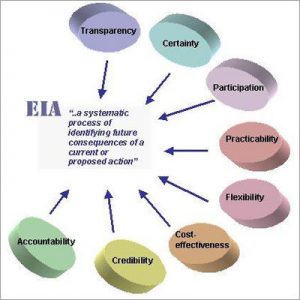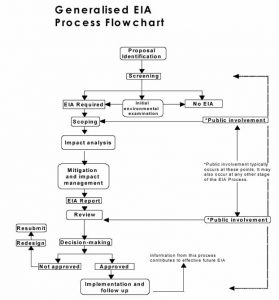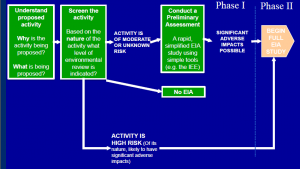
Table of Contents
What is EIA?
- Environmental Impact Assessment (EIA) is the assessment/measurement of impacts of any activities on the environment
- It is the estimation of what would be the possible impact of any proposed or planned activity on the environment level i.e. assessment of possible environmental consequences due to certain activity
- According to United Nations Environment Program Training Resource Manual, EIA is a process which provides information about the “prediction of how environment is expected to change if certain alternative actions are implemented and advice on how best to manage environmental changes if one alternative is selected and implemented.”
- UNEP also considers EIA as a method to identify environmental, social and economic impact of an activity before making the decision to implement it
- EIA helps to determine the level of positive/negative effect of the proposed activity on environment and suggests relevant managerial actions to reduce the harmful effects

- The prime objective of EIA is to inform the decision makers about the possible impact of proposed activity before making the final decision. Therefore, EIA is also considered as a valuable input for decision making about the proposed activity
- EIA can be decided both at short term and long term risks to the environment
- To assess the environmental impact, we must be well aware about the baseline situation of the environment i.e. existing situation of the environment before the start of the activity
- Environmental impact is actually the deviation/change in environmental situation due to certain activity
- It can be also referred as a process in which the environmental implication of an activity is assessed before reaching to a final conclusion of implementing the activity
- EIA is done while conducting almost all sorts of activities like: building a dam, cutting down trees, road construction, establishing industries, building power houses etc
- EIA conducting team includes people from diverse background who can make better and neutral decisions. This will also include public participation in decision making so that the quality of decision is stronger. Thus, public consultation is an important feature of EIA
- Different nations of the world have their own EIA guideline and follow their assessment method in order to provide high level of protection to the environment
- Also, in EIA, different types of impacts on the environment are assessed:
- Direct and indirect impact
- Short term and long term impact
- Adverse and beneficial impact and
- Cumulative impact.
- However, all impacts are not given equal importance/priority
- While talking about EIA, we must also realize that all activities might have some sort of negative impact on the environment. However, what EIA ensures is that the level of negative impact that can be created by an activity is at a very minimum level and high priority is always set for environmental protection
- EIA process ensures that the environmental issues are discussed from the very beginning stage where the activity is planned or decided to implement. Then, necessary actions are taken by the project side to rectify the concerned issues.
- These necessary actions can be anything as small as making a minor change in the process or changing the entire design, modality and other prospects of the project cycle
Generalized EIA process flowchart:

Different phases of EIA process includes:

-
Brief explanation of phases/stages of EIA study is given below:
- In the 1st stage, EIA team tries to understand the proposed activity by looking at the answer of two major questions: ‘what is being proposed’ and ‘why is it being proposed’? Answer to these questions determines whether the activity can be undertaken or not.
- Then, screening of each activity is done through assessing the nature of proposed activity. This process does not involve detailed analysis or knowledge of the activity
- On the basis of screening, the proposed activity is divided into different categories based on risk to the environment: very low risk category (which means end of EIA activity), or moderate or unknown risk category (which suggests to do preliminary assessment) or very high risk category (which suggests to do full EIA study)
- In case of conducting preliminary assessment (which is done for moderate or unknown risk category), a very simple EIA process is followed using simplified tools. However, if the result of preliminary assessment shows the possibility of significant adverse impact, then we need to conduct full EIA study. However, usually, full EIA study is not required in case of small scale projects
-
Moreover, although brief explanation about the simple way of initiating EIA study is described above for our simplicity, there are certain fundamental steps which are usually followed by all the institutions or different governmental bodies while conducting EIA. They are:
- Screening- (explained above)
- Scoping- process of determining the most critical issues that are needed to study
- Assessment and evaluation of impacts and development of alternatives
- Reporting the Environmental Impact Statement (EIS) or EIA report
- Review of the Environmental Impact Statement (EIS)
- Decision-making
- Monitoring, compliance, enforcement and environmental auditing
- Likewise, in case of full EIA study certain things must be ensured for transparency, reliability and accuracy:
- Public Participation
- Professional EIA team
- Detailed analysis of environmental impacts
- Setting of the alternatives and the impact of each alternatives must be identified, evaluated and compared
References
http://www.epa.ie/monitoringassessment/assessment/eia/
http://www.fao.org/docrep/V8350E/v8350e06.htm
http://ec.europa.eu/environment/eia/index_en.htm
http://www.uow.edu.au/~sharonb/STS218/eis/what.html
https://www.journals.elsevier.com/environmental-impact-assessment-review
https://www.cbd.int/impact/whatis.shtml
https://www.sciencedaily.com/terms/environmental_impact_assessment.htm
http://www.businessdictionary.com/definition/environmental-impact-assessment-EIA.html
https://stats.oecd.org/glossary/detail.asp?ID=828
https://www.gov.uk/guidance/environmental-impact-assessment
https://www.journals.elsevier.com/environmental-impact-assessment-review/most-downloaded-articles
http://www.sciencedirect.com/science/journal/01959255
http://www.sciencedirect.com/science/article/pii/S0195925506001338
https://www.unece.org/fileadmin/DAM/env/eia/documents/legaltexts/Espoo_Convention_authentic_ENG.pdf
http://www.ats.aq/e/ep_eia.htm
http://onlinelibrary.wiley.com/doi/10.1111/jiec.12371/abstract